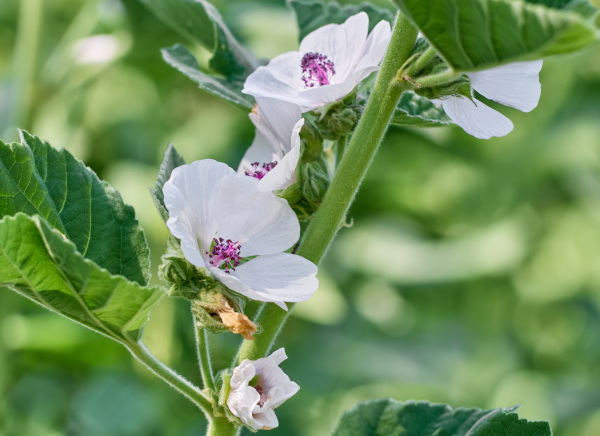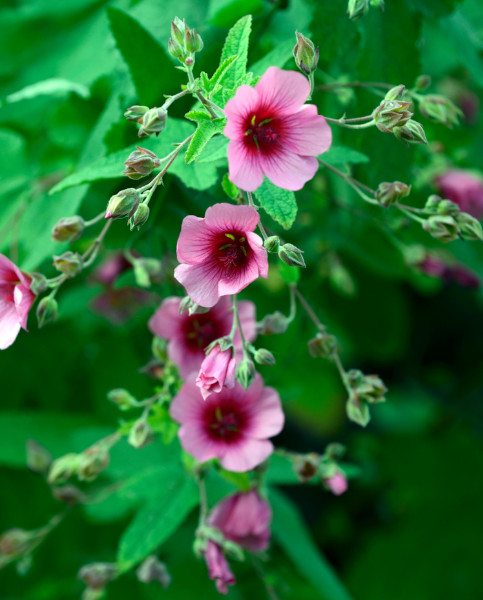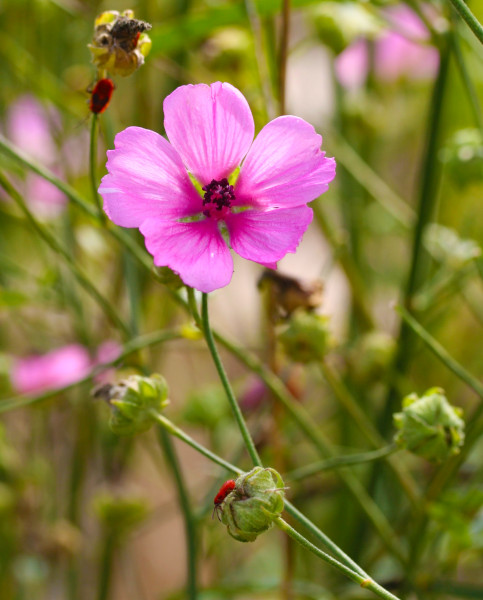How to grow Althaea
Unmistakeably a member of the mallow family (hollyhock, hibiscus, lavatera etc.), althaea is a genus of approximately 12 species of annuals and perennials. It is similar in appearance to hollyhock, though has smaller, more delicate flowers which are usually held on branching stalks rather than a single flower spike. The most notable and commonly cultivated species are Althaea cannabina or hemp-leaved marsh mallow – an airy plant from the Mediterranean with wiry stems and sprays of pink flowers; and A. officinalis or marsh mallow – a more substantial, bushy, UK native plant with paler, clustered flowers. These are both grown for their later season of interest (blooming summer into autumn) when many other flowers are running out of steam.
Somewhat confusingly, the latin name Althaea is a synonym for Alcea (hollyhock), though for the purposes of this growing guide we shall disregard this and stick with the marsh mallows.
On that matter and in answer to the inevitable question – yes, there is a link between this plant and the sugary treat of the same name. Marshmallows were originally made by mixing the sweet, gelatinous substance found when squeezing the roots of A. officinalis with egg whites, honey, and cornstarch. Today they are made with a synthetic substitute.

Key Information
Soil pH
Position
Hardiness


Where to plant Althaea
For best results, plant in autumn or spring. An autumn planting can be done by those gardening in mild conditions (and broadly speaking, this is the southern half of the UK). For those liable to cold winters, it is best to wait until spring (generally the northern half of the UK). Planting can also be carried out in summer, though be prepared to water regularly.
Althaea is a tall plant perfect for adding height and late season colour to the back of a border. Althaea cannabina will also do well in a dry or Mediterranean garden, while the native Althaea officinalis is a good choice for a wildlife garden.
A deep tap root rules out long-term success in a container, though you may have satisfactory results for a year or two in a deep pot.
How to plant Althaea
- For planting in the garden, dig the soil area removing any large stones and weeds and breaking up any lumps. It can be a good idea to mix in some organic matter such as manure or garden compost at this stage, particularly if you have very poor or heavy soil.
- Rake level and firm with your heels. Rake level again.
- Water plants well and allow to drain before planting.
- A good tip is to dig a hole twice the size of the root-ball. Fill with water and allow to drain before placing in the plant.
- Place the plant in the hole, ensuring the top of the root ball sits level with the surface of the soil. Too low and the plant may rot, too high and the roots can dry out.
- Backfill with soil and firm in gently with your foot.
- Soak well with water.
- Mulch around the base with well-rotted organic matter.
- For planting in containers, choose a deep pot with plenty of drainage holes in the bottom. You may wish to grow your althaea in a pot of its own (in which case choose one 5-10cm larger than the current diameter of the rootball) or in a larger mixed container.
- If you are using a large or heavy pot, it can be a good idea to fill and plant it in situ to save yourself the trouble of moving once full.
- Use a good quality potting compost with some horticultural grit mixed in and, if not already present (check the labelling on the bag) some slow-release fertiliser granules.
- Start by partially filling the pot with compost; enough so that when placed on it the upper surface of the root ball is about 3cm lower than the top of the pot.
- Fill around the plant with compost, firming down with your fingers then adding a little more so it is held tight.
- Pick up the container (if you can!) and lightly tap on the potting bench or ground a few times to help further settle the compost around the plant.
- Soak well with water.
- A mulch with horticultural grit will look attractive and help to prevent a ‘cap’ or crust forming on the top of the compost (something container plants can suffer due to the artificial nature of their watering).

How to care for Althaea
Pruning and Deadheading
No deadheading is required.
Simply cut the lot down to the ground once flowering is over.
Watering
Give althaea a good initial soaking, then a few more over the following weeks while its roots establish. Allowing the top few centimetres of soil to dry out between each time is a good way to avoid overwatering. Wiggle your finger down until you feel moisture to check this.
Once established, A. cannabina should be self sufficient in all but the most prolonged dry periods. A. officinalis, on the other hand, prefers consistent moisture. If you’ve planted it in moisture retentive soil and given it a good mulch, it should need little attention, again in all but the hottest and driest of weather. Otherwise, you’ll need to keep an eye on watering throughout the summer.
Container-grown althea will need plenty of water throughout the growing season. Again, allow the top few centimetres of compost to dry out between each time, using the finger wiggle technique above.
Feeding
On healthy, fertile soil, a mulch of well-rotted organic matter (i.e., a layer of leaf mould, manure, or garden compost applied to the soil around the plant) should provide enough nutrients for your althaea. This has the added benefit of suppressing weeds and locking in moisture. Mulch when planting, and then again each spring.
If you garden on very poor soil or your althaea looks in need of a boost, applying a granular general-purpose feed to the surface of the soil and lightly working in can reap benefits. This is known as a top dress and should be done when mulching in spring – first apply the feed, then cover with the mulch.
Container-grown plants are different as they have a limited root run and rely solely on the gardener for nutrition. Get off to a flying start by making sure you use a good quality compost with slow-release granules mixed in. These generally provide nutrients for around 6 to 8 weeks, after which a balanced liquid feed is advisable, once a month until the end of the growing season (i.e., September-ish).
Your althaea is likely to tire of life in a pot after a couple of years, being far happier in the open ground where its deep taproot can roam free. Either replace with new, try repotting into a larger pot, or rehome into a border.
Cold Protection
Althaea is fully hardy and able to get through a winter anywhere in the UK without the need for additional protection.
Pests and Diseases
Althaea tends to be fairly robust, though like all members of the malvaceae family, can succumb to rust. This fungal disease causes spotting and discolouration of foliage, and in severe cases can stunt the growth of the plant.
A few simple steps can be taken to reduce the risk of this, such as not planting too densely, and minimising the presence of other malvaceae plants nearby (as above). If rust does arrive, remove and dispose of any affected leaves as soon as you can. Very heavily infected plants should be taken out altogether.
One other potential pitfall is flea beetle, a tiny insect responsible for the riddling of leaves with many tiny holes. This tends not to affect the overall health of plants too much, though it can spoil their appearance. If you are really bothered by this, try exploiting the beetles’ habit of jumping when disturbed by coating a piece of card with insect barrier glue and brushing it over the top of plants. This allows you to trap and dispose of the offending pests, though does need to be done repeatedly in order to have any great effect.
How to propagate Althaea
For best results, propagate althaea by seed. These need a period of cold stratification to germinate, so are best sown in late summer to autumn and placed outside. If you wish to sow them in spring, you’ll need to artificially recreate winter by mixing the seeds with a little damp sand or vermiculite in a poplythene bag, and putting this in the fridge for 3-6 weeks prior to sowing.
- Seeds are typically ready for collecting in late summer to autumn when they’ve turned hard and black.
- Snip the seedheads from the plant using scissors or secateurs. Try to do this in dry conditions, and shake the seeds into a small, labelled paper bag or envelope.
- Fill a seed tray, module tray or small pots with a well-draining compost mix, compressing the surface lightly with a flat piece of wood or the bottom of another pot.
- Sprinkle the seeds evenly over the surface of the compost.
- Use a garden sieve to cover with a fine layer of compost.
- Water the soil gently with a fine spray until it is evenly moist but not waterlogged.
- Place the tray or pots in a sheltered spot outside, such as in an open cold frame or in the lee of a wall.
- When the seedlings have developed their first ‘true leaves’, carefully prick out and grow on until they are large enough to plant out into the garden, following our ‘How to plant althea’ section above.
* Many plants carry Plant Breeders Rights and cannot be propagated for commercial purposes.
Common Althea questions
- Is Althaea suitable for a coastal garden?
Yes, it is known to tolerate salty conditions well. - Should I stake Althaea cannabina?
In poorer, drier soils this species seldom requires support, however in richer, more moist conditions it can become large and floppy. In these cases, it’s a good idea to provide support at the beginning of the growing season. Metal link stakes, or a network of twigs and branches inserted around the plant both work well.




